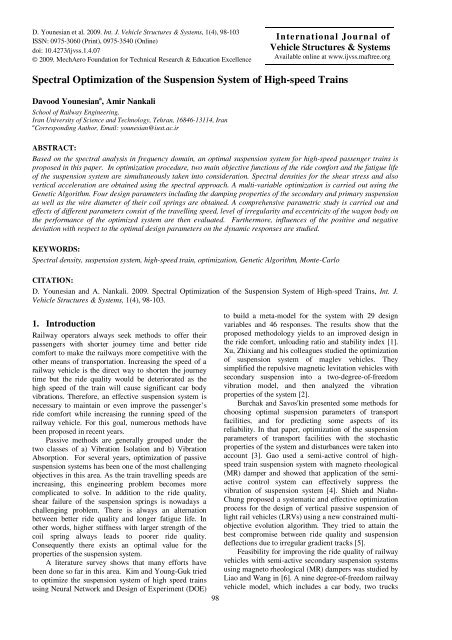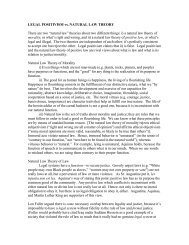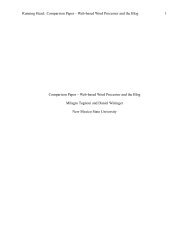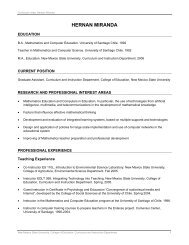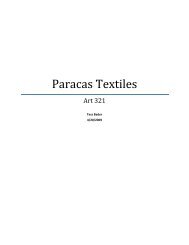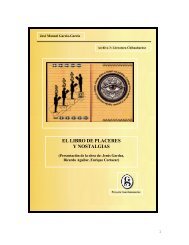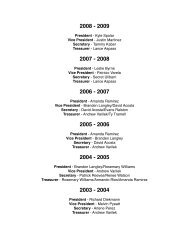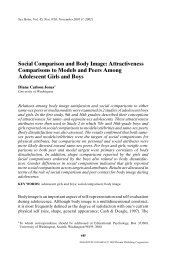Spectral Optimization of the Suspension System of High-speed Trains
Spectral Optimization of the Suspension System of High-speed Trains
Spectral Optimization of the Suspension System of High-speed Trains
Create successful ePaper yourself
Turn your PDF publications into a flip-book with our unique Google optimized e-Paper software.
D. Younesian et al. 2009. Int. J. Vehicle Structures & <strong>System</strong>s, 1(4), 98-103<br />
ISSN: 0975-3060 (Print), 0975-3540 (Online)<br />
doi: 10.4273/ijvss.1.4.07<br />
© 2009. MechAero Foundation for Technical Research & Education Excellence<br />
98<br />
International Journal <strong>of</strong><br />
Vehicle Structures & <strong>System</strong>s<br />
Available online at www.ijvss.maftree.org<br />
<strong>Spectral</strong> <strong>Optimization</strong> <strong>of</strong> <strong>the</strong> <strong>Suspension</strong> <strong>System</strong> <strong>of</strong> <strong>High</strong>-<strong>speed</strong> <strong>Trains</strong><br />
Davood Younesian a , Amir Nankali<br />
School <strong>of</strong> Railway Engineering,<br />
Iran University <strong>of</strong> Science and Technology, Tehran, 16846-13114, Iran<br />
a Corresponding Author, Email: younesian@iust.ac.ir<br />
ABSTRACT:<br />
Based on <strong>the</strong> spectral analysis in frequency domain, an optimal suspension system for high-<strong>speed</strong> passenger trains is<br />
proposed in this paper. In optimization procedure, two main objective functions <strong>of</strong> <strong>the</strong> ride comfort and <strong>the</strong> fatigue life<br />
<strong>of</strong> <strong>the</strong> suspension system are simultaneously taken into consideration. <strong>Spectral</strong> densities for <strong>the</strong> shear stress and also<br />
vertical acceleration are obtained using <strong>the</strong> spectral approach. A multi-variable optimization is carried out using <strong>the</strong><br />
Genetic Algorithm. Four design parameters including <strong>the</strong> damping properties <strong>of</strong> <strong>the</strong> secondary and primary suspension<br />
as well as <strong>the</strong> wire diameter <strong>of</strong> <strong>the</strong>ir coil springs are obtained. A comprehensive parametric study is carried out and<br />
effects <strong>of</strong> different parameters consist <strong>of</strong> <strong>the</strong> travelling <strong>speed</strong>, level <strong>of</strong> irregularity and eccentricity <strong>of</strong> <strong>the</strong> wagon body on<br />
<strong>the</strong> performance <strong>of</strong> <strong>the</strong> optimized system are <strong>the</strong>n evaluated. Fur<strong>the</strong>rmore, influences <strong>of</strong> <strong>the</strong> positive and negative<br />
deviation with respect to <strong>the</strong> optimal design parameters on <strong>the</strong> dynamic responses are studied.<br />
KEYWORDS:<br />
<strong>Spectral</strong> density, suspension system, high-<strong>speed</strong> train, optimization, Genetic Algorithm, Monte-Carlo<br />
CITATION:<br />
D. Younesian and A. Nankali. 2009. <strong>Spectral</strong> <strong>Optimization</strong> <strong>of</strong> <strong>the</strong> <strong>Suspension</strong> <strong>System</strong> <strong>of</strong> <strong>High</strong>-<strong>speed</strong> <strong>Trains</strong>, Int. J.<br />
Vehicle Structures & <strong>System</strong>s, 1(4), 98-103.<br />
1. Introduction<br />
Railway operators always seek methods to <strong>of</strong>fer <strong>the</strong>ir<br />
passengers with shorter journey time and better ride<br />
comfort to make <strong>the</strong> railways more competitive with <strong>the</strong><br />
o<strong>the</strong>r means <strong>of</strong> transportation. Increasing <strong>the</strong> <strong>speed</strong> <strong>of</strong> a<br />
railway vehicle is <strong>the</strong> direct way to shorten <strong>the</strong> journey<br />
time but <strong>the</strong> ride quality would be deteriorated as <strong>the</strong><br />
high <strong>speed</strong> <strong>of</strong> <strong>the</strong> train will cause significant car body<br />
vibrations. Therefore, an effective suspension system is<br />
necessary to maintain or even improve <strong>the</strong> passenger’s<br />
ride comfort while increasing <strong>the</strong> running <strong>speed</strong> <strong>of</strong> <strong>the</strong><br />
railway vehicle. For this goal, numerous methods have<br />
been proposed in recent years.<br />
Passive methods are generally grouped under <strong>the</strong><br />
two classes <strong>of</strong> a) Vibration Isolation and b) Vibration<br />
Absorption. For several years, optimization <strong>of</strong> passive<br />
suspension systems has been one <strong>of</strong> <strong>the</strong> most challenging<br />
objectives in this area. As <strong>the</strong> train travelling <strong>speed</strong>s are<br />
increasing, this engineering problem becomes more<br />
complicated to solve. In addition to <strong>the</strong> ride quality,<br />
shear failure <strong>of</strong> <strong>the</strong> suspension springs is nowadays a<br />
challenging problem. There is always an alternation<br />
between better ride quality and longer fatigue life. In<br />
o<strong>the</strong>r words, higher stiffness with larger strength <strong>of</strong> <strong>the</strong><br />
coil spring always leads to poorer ride quality.<br />
Consequently <strong>the</strong>re exists an optimal value for <strong>the</strong><br />
properties <strong>of</strong> <strong>the</strong> suspension system.<br />
A literature survey shows that many efforts have<br />
been done so far in this area. Kim and Young-Guk tried<br />
to optimize <strong>the</strong> suspension system <strong>of</strong> high <strong>speed</strong> trains<br />
using Neural Network and Design <strong>of</strong> Experiment (DOE)<br />
to build a meta-model for <strong>the</strong> system with 29 design<br />
variables and 46 responses. The results show that <strong>the</strong><br />
proposed methodology yields to an improved design in<br />
<strong>the</strong> ride comfort, unloading ratio and stability index [1].<br />
Xu, Zhixiang and his colleagues studied <strong>the</strong> optimization<br />
<strong>of</strong> suspension system <strong>of</strong> maglev vehicles. They<br />
simplified <strong>the</strong> repulsive magnetic levitation vehicles with<br />
secondary suspension into a two-degree-<strong>of</strong>-freedom<br />
vibration model, and <strong>the</strong>n analyzed <strong>the</strong> vibration<br />
properties <strong>of</strong> <strong>the</strong> system [2].<br />
Burchak and Savos'kin presented some methods for<br />
choosing optimal suspension parameters <strong>of</strong> transport<br />
facilities, and for predicting some aspects <strong>of</strong> its<br />
reliability. In that paper, optimization <strong>of</strong> <strong>the</strong> suspension<br />
parameters <strong>of</strong> transport facilities with <strong>the</strong> stochastic<br />
properties <strong>of</strong> <strong>the</strong> system and disturbances were taken into<br />
account [3]. Gao used a semi-active control <strong>of</strong> high<strong>speed</strong><br />
train suspension system with magneto rheological<br />
(MR) damper and showed that application <strong>of</strong> <strong>the</strong> semiactive<br />
control system can effectively suppress <strong>the</strong><br />
vibration <strong>of</strong> suspension system [4]. Shieh and Niahn-<br />
Chung proposed a systematic and effective optimization<br />
process for <strong>the</strong> design <strong>of</strong> vertical passive suspension <strong>of</strong><br />
light rail vehicles (LRVs) using a new constrained multiobjective<br />
evolution algorithm. They tried to attain <strong>the</strong><br />
best compromise between ride quality and suspension<br />
deflections due to irregular gradient tracks [5].<br />
Feasibility for improving <strong>the</strong> ride quality <strong>of</strong> railway<br />
vehicles with semi-active secondary suspension systems<br />
using magneto rheological (MR) dampers was studied by<br />
Liao and Wang in [6]. A nine degree-<strong>of</strong>-freedom railway<br />
vehicle model, which includes a car body, two trucks
D. Younesian et al. 2009. Int. J. Vehicle Structures & <strong>System</strong>s, 1(4), 98-103<br />
four wheel sets, was proposed to cope with vertical,<br />
pitch and roll motions <strong>of</strong> <strong>the</strong> car body and trucks. The<br />
LQG control law using <strong>the</strong> acceleration feedback was<br />
adopted as <strong>the</strong> system controller, in which <strong>the</strong> state<br />
variables were estimated from <strong>the</strong> measurable<br />
accelerations with <strong>the</strong> Kalman estimator. Inter-vehicle<br />
active suspension for railway vehicles was proposed by<br />
Mei et al [7]. They developed a new optimization<br />
process for <strong>the</strong> design <strong>of</strong> vertical active suspension<br />
controllers using multi-objective genetic algorithm.<br />
Performance <strong>of</strong> neural network for <strong>the</strong> identification<br />
and optimal control <strong>of</strong> active pneumatic suspensions <strong>of</strong><br />
high-<strong>speed</strong> railway vehicles was studied by Nagai et al.<br />
in [8]. It was shown that neural networks can be<br />
efficiently trained to identify <strong>the</strong> dynamics <strong>of</strong> nonlinear<br />
pneumatic suspensions, as well as being trained to work<br />
as optimal nonlinear controllers. Zolotas et al. [9]<br />
presented a work on a set <strong>of</strong> novel strategies for<br />
achieving local tilt control, i.e. applied independently for<br />
each vehicle ra<strong>the</strong>r than <strong>the</strong> whole train precedence<br />
approach that is being commonly used. A linearized<br />
dynamic model was developed for a modern tilting<br />
railway vehicle with a tilt mechanism (tilting bolster)<br />
providing tilt below <strong>the</strong> secondary suspension.<br />
Surveying <strong>the</strong> literature shows that in most <strong>of</strong> <strong>the</strong><br />
published works just one <strong>of</strong> <strong>the</strong> objective functions <strong>of</strong><br />
ride quality or static strength <strong>of</strong> <strong>the</strong> suspension system<br />
have been solely taken into account because <strong>of</strong> <strong>the</strong><br />
simplification. The present paper is aimed to propose a<br />
technique to optimize <strong>the</strong> system simultaneously<br />
obtaining <strong>the</strong> desired ride quality and static strength.<br />
Fur<strong>the</strong>rmore, it should be noted that most <strong>of</strong> <strong>the</strong> works<br />
already done in this area are mainly dealing with <strong>the</strong><br />
optimization in <strong>the</strong> time domain. Consequently, in such<br />
optimization procedures, <strong>the</strong> obtained results severely<br />
become dependent on <strong>the</strong> nature <strong>of</strong> irregularly input<br />
data. In <strong>the</strong> present research, <strong>the</strong> corrugation pr<strong>of</strong>ile is<br />
simulated with its spectral density which intrinsically<br />
contains several sample data. In o<strong>the</strong>r words, <strong>the</strong> selected<br />
approach makes <strong>the</strong> procedure more general and reliable<br />
for variety <strong>of</strong> <strong>the</strong> irregularity inputs.<br />
A multi-variable optimization is carried out using<br />
<strong>the</strong> Genetic Algorithm. Four design parameters <strong>of</strong><br />
damping coefficient <strong>of</strong> <strong>the</strong> secondary and primary<br />
suspension as well as <strong>the</strong> wire diameter <strong>of</strong> <strong>the</strong>ir coil<br />
springs are obtained. Contribution <strong>of</strong> <strong>the</strong> paper is mainly<br />
directed to <strong>the</strong> new concepts <strong>of</strong> a) <strong>Optimization</strong> in<br />
random frequency domain which is more realistic, b)<br />
Combinational objective function simultaneously dealing<br />
with minimum body acceleration and maximum fatigue<br />
life. A parametric study is carried out and performance<br />
<strong>of</strong> <strong>the</strong> proposed optimal suspension system is evaluated<br />
for different values <strong>of</strong> <strong>the</strong> operational <strong>speed</strong>, corrugation<br />
level and also eccentricity <strong>of</strong> <strong>the</strong> wagon body. Effects <strong>of</strong><br />
positive and negative deviation with respect to <strong>the</strong><br />
optimal design parameters on <strong>the</strong> dynamic responses are<br />
<strong>the</strong>n studied.<br />
2. Ma<strong>the</strong>matical Modelling<br />
The wagon model is schematically illustrated in Fig. 1,<br />
in which <strong>the</strong> carriage body is connected with two bogies,<br />
via secondary suspension system indicated by Kss and<br />
99<br />
Css. The coach body has vertical and pitch motions in<br />
<strong>the</strong> vertical plane. Wheel-sets are connected to bogies<br />
via primary suspension system denoted by Kps and Cps.<br />
Contact between wheel and rail is modelled by linear<br />
Hertzian contact spring and is shown by KH.<br />
Fig. 1(a): SKS300 <strong>High</strong>-<strong>speed</strong> train<br />
Fig. 1(b): Schematic model <strong>of</strong> <strong>the</strong> passenger train wagon<br />
According to <strong>the</strong> model, <strong>the</strong> equations <strong>of</strong> motion <strong>of</strong><br />
<strong>the</strong> carriage components are derived as follow:<br />
[ m ] { & x&<br />
} + [ C]<br />
{ x&<br />
} + [ K]<br />
{ x}<br />
= { f }<br />
In which:<br />
(1)<br />
{f} = External force vector<br />
[m] = Mass matrix<br />
[c] = Damping matrix<br />
[k] = Stiffness matrix<br />
{x} = Displacement vector<br />
H ω can be <strong>the</strong>n obtained by<br />
Harmonic transfer matrix ( )<br />
[ ] [ ] [ ] 1<br />
2<br />
H( −<br />
) = [ −ω<br />
M + i C ω + K ]<br />
ω<br />
Consequently:<br />
(2)<br />
⎡ 2<br />
2 2 2 2<br />
−Ibdω<br />
+ iω<br />
( Css<br />
1( + e)<br />
+ Css(<br />
1−e)<br />
) + 1( −e)<br />
Kss<br />
+ ( 1+<br />
e)<br />
Kss<br />
2iωeC<br />
ss+<br />
2eK<br />
ss −iω(<br />
Css(<br />
1+<br />
e))<br />
−Kss<br />
( 1+<br />
e)<br />
⎢<br />
2<br />
⎢<br />
iω<br />
( 2eC<br />
ss)<br />
+ 2eK<br />
ss<br />
−Mbdω<br />
+ 2iωC<br />
ss+<br />
2Kss<br />
−iωC<br />
ss−Kss<br />
⎢<br />
−iω<br />
( Css(<br />
1+<br />
e))<br />
−Kss(<br />
1+<br />
e)<br />
−iωC<br />
ss−Kss<br />
−Mbg<br />
+ iω(<br />
Cps+<br />
Css)<br />
+ Kps<br />
+ Kss<br />
H(<br />
ω)<br />
= ⎢<br />
⎢<br />
iω<br />
Css(<br />
1−e)<br />
+ Kss(<br />
1−e)<br />
−iωC<br />
ss−Kss<br />
0<br />
⎢<br />
0<br />
0<br />
−iωC<br />
_<br />
⎢<br />
ps Kps<br />
⎢⎣<br />
0<br />
0<br />
0<br />
−1<br />
iωC<br />
ss ( 1 − e)<br />
+ K ss ( 1 − e)<br />
0<br />
0<br />
⎤<br />
− iωC<br />
0<br />
0<br />
⎥<br />
ss − K ss<br />
⎥<br />
0<br />
− iωC<br />
_<br />
0<br />
⎥<br />
ps K ps<br />
⎥<br />
− M bg _ iω(<br />
Css<br />
+ C ps ) + K ps + K ss<br />
0<br />
− iωC<br />
ps _ K ps ⎥<br />
0<br />
− M + 2 + +<br />
0<br />
⎥<br />
w KH K ps iωC<br />
ps<br />
⎥<br />
− iωC<br />
ps − K ps<br />
0<br />
− M w _ iωC<br />
ps + 2KH<br />
+ K ps ⎥⎦<br />
(3)<br />
In which, MBD and MBG are respectively <strong>the</strong> body and<br />
bogie mass and IBD represents <strong>the</strong> body mass inertia.<br />
Subscripts ss and ps denote secondary and primary<br />
suspension systems. The main excitation <strong>of</strong> such a<br />
dynamical system arises from <strong>the</strong> rail corrugation. Rail<br />
corrugation consists <strong>of</strong> undesirable fluctuations in wear<br />
on railway track and costs <strong>the</strong> railway industry<br />
substantially for its removal by regrinding.
D. Younesian et al. 2009. Int. J. Vehicle Structures & <strong>System</strong>s, 1(4), 98-103<br />
Using above equation spectral density matrix <strong>of</strong><br />
displacement can be calculated as:<br />
T*<br />
S ( ω ) = H ( ω)<br />
S ( ω)<br />
H ( w)<br />
(4)<br />
xx<br />
ff<br />
In which S ff is density matrix <strong>of</strong> forces:<br />
S<br />
y<br />
ff<br />
⎡0<br />
⎢<br />
⎢<br />
0<br />
⎢0<br />
= ⎢<br />
⎢0<br />
⎢0<br />
⎢<br />
⎢⎣<br />
0<br />
0<br />
0<br />
0<br />
0<br />
0<br />
0<br />
0<br />
0<br />
0<br />
0<br />
0<br />
0<br />
0<br />
0<br />
0<br />
0<br />
0<br />
0<br />
KH<br />
KH<br />
0<br />
0<br />
0<br />
0<br />
2<br />
2<br />
S<br />
S<br />
y<br />
y<br />
0 ⎤<br />
0<br />
⎥<br />
⎥<br />
0 ⎥<br />
⎥<br />
0 ⎥<br />
2<br />
KH S ⎥<br />
y<br />
⎥ 2<br />
KH S y ⎥⎦<br />
S is spectral density <strong>of</strong> <strong>the</strong> base displacement:<br />
S(<br />
Ω)<br />
S y ( ω ) =<br />
(6)<br />
v<br />
In which, ν is <strong>the</strong> train <strong>speed</strong>.<br />
Track irregularity is assumed to be a random<br />
function characterized by <strong>the</strong> following power spectral<br />
density (PSD) function S(Ω) [7-8]:<br />
(5)<br />
AΩ2<br />
S ( Ω)<br />
=<br />
(7)<br />
2 2 2 2<br />
( Ω + Ω )( Ω + Ω )<br />
1<br />
2<br />
In which ⎛ 2π × ω ⎞<br />
Ω = ⎜ ⎟ denotes <strong>the</strong> spatial frequency<br />
⎝ v ⎠<br />
(rad/m), and A(m), Ω1 (rad/m) and Ω2 (rad/m) are<br />
relevant parameters indicated in Table 1. This spectrum<br />
is based on <strong>the</strong> measurements made on <strong>the</strong> railways <strong>of</strong><br />
<strong>the</strong> USA [12]. ‘Class 6’ and ‘Class 1’ correspond to <strong>the</strong><br />
best and <strong>the</strong> worst quality respectively.<br />
Table 1: Parameters <strong>of</strong> different tracks [11-12]<br />
Track Class 4 5 6<br />
A (m) 2.39X10 -5 9.35X10 -6 1.5X10 -6<br />
Ω1 (rad/m) 2.06X10 -2 2.06X10 -2 2.06X10 -2<br />
Ω2 (rad/m) 0.825 0.825 0.825<br />
2<br />
Acceleration mean square <strong>the</strong>n can be derived by:<br />
[ ] = ∫ ( )<br />
+∞<br />
ω ω<br />
ii<br />
2 4<br />
x&<br />
i Sxx<br />
E & (8)<br />
−∞<br />
The o<strong>the</strong>r objective <strong>of</strong> <strong>the</strong> optimization procedure is<br />
shear stress in coil springs with spectral density <strong>of</strong>:<br />
2<br />
⎛ 8D<br />
⎞<br />
τ a ( ω)<br />
= ⎜ K B ⎟ 3<br />
⎝ πd<br />
⎠<br />
Ssf<br />
( ω)<br />
(9)<br />
4C<br />
+ 2<br />
K B =<br />
4C<br />
− 3<br />
(10)<br />
In which D and d are respectively spring and coil<br />
diameter and C = d<br />
S ω is <strong>the</strong><br />
D / is Spring Index. ( )<br />
force spectral density and can be calculated for primary<br />
suspension springs as:<br />
2 ii ij ji jj<br />
S ω = K ( S ω − S ω − S ω + S ω (11)<br />
sf<br />
( ) ( ) ( ) ( ) ( ))<br />
spring<br />
xx<br />
xx<br />
and for secondary suspension springs <strong>of</strong> <strong>the</strong> front bogie<br />
as:<br />
S<br />
sf<br />
( l +<br />
2 ii ij ji jj<br />
( ω)<br />
= K spring [ Sxx<br />
( ω)<br />
− S xx ( ω)<br />
− S xx ( ω)<br />
+ S xx ( ω)<br />
+<br />
ik ki jk kj<br />
2 kk<br />
e)(<br />
S ( ω)<br />
+ S ( ω)<br />
− S ( ω)<br />
− S ( ω)<br />
) + ( l + e)<br />
S ( ω)]<br />
xx<br />
xx<br />
xx<br />
xx<br />
xx<br />
sf<br />
xx<br />
xx<br />
(12)<br />
100<br />
and for secondary suspension springs <strong>of</strong> <strong>the</strong> rear bogie<br />
as:<br />
S<br />
sf<br />
( l −<br />
2 ii ij ji jj<br />
( ω)<br />
= Kspring[<br />
Sxx<br />
( ω)<br />
− Sxx(<br />
ω)<br />
− Sxx<br />
( ω)<br />
+ Sxx(<br />
ω)<br />
−<br />
ik ki jk kj<br />
2 kk<br />
e)(<br />
S ( ω)<br />
+ S ( ω)<br />
− S ( ω)<br />
− S ( ω ) + ( l − e)<br />
S ( ω)]<br />
In which<br />
xx<br />
xx<br />
xx<br />
xx<br />
xx<br />
(13)<br />
ij<br />
S xx is i th row and j th column <strong>of</strong> S xx matrix. i<br />
denote vertical motion <strong>of</strong> body, j denotes vertical motion<br />
<strong>of</strong> rear and front bogies and k denotes degree <strong>of</strong> freedom<br />
associated with <strong>the</strong> pitch motion <strong>of</strong> body.<br />
Using Monte Carlo simulation algorithm [13], <strong>the</strong><br />
applied random surface can be generated. According to<br />
this simulation algorithm, <strong>the</strong> random pr<strong>of</strong>ile <strong>of</strong> <strong>the</strong> rail<br />
surface can be generated by:<br />
N<br />
f ( x)<br />
∑ 2 PSD ( ω ) ∆ω<br />
cos( ω x + ε )<br />
=<br />
j=<br />
1<br />
f<br />
j<br />
j<br />
j<br />
(14)<br />
In which εj is a random number between 0 to 2π and<br />
with normal probability density function and<br />
1<br />
ω j = ω1<br />
+ ( j − ) ∆ω<br />
; j = 1,<br />
2,...<br />
N<br />
(15)<br />
2<br />
( ωN<br />
− ω1)<br />
∆ ω =<br />
(16)<br />
N<br />
and N is sufficiently large integer (1000 in this paper).<br />
Using Monte-Carlo simulation, <strong>the</strong> irregularity pr<strong>of</strong>ile<br />
has been generated for three types <strong>of</strong> <strong>the</strong> rail classes and<br />
illustrated in Fig. 2.<br />
Y (m)<br />
0.25<br />
0.2<br />
0.15<br />
0.1<br />
0.05<br />
0<br />
0 200 400 600 800 1000 1200<br />
-0.05<br />
-0.1<br />
-0.15<br />
-0.2<br />
X(m)<br />
Fig. 2: Track irregularities generated for three types <strong>of</strong> tracks<br />
track 1<br />
track 2<br />
track 3<br />
Genetic algorithm is used as <strong>the</strong> optimization<br />
technique and a multi-variable optimization is carried<br />
out. The algorithm is directed to simultaneously optimize<br />
both objective functions i.e. RMS <strong>of</strong> <strong>the</strong> body<br />
acceleration as well as <strong>the</strong> shear stress. Four design<br />
parameters <strong>of</strong> damping coefficients <strong>of</strong> <strong>the</strong> secondary and<br />
primary suspension systems as well as <strong>the</strong> wire diameter<br />
<strong>of</strong> <strong>the</strong>ir coil springs are obtained. Flow-chart <strong>of</strong> <strong>the</strong><br />
implemented genetic algorithm is illustrated in Fig. 3.<br />
3. Numerical Results<br />
For a real high-<strong>speed</strong> wagon having mechanical<br />
properties listed in Table 2, numerical optimization is<br />
carried out and optimal values <strong>of</strong> <strong>the</strong> design parameters<br />
are obtained. Variation <strong>of</strong> <strong>the</strong> non dimension<br />
acceleration and shear stress are plotted with respect to<br />
values <strong>of</strong> secondary suspension damping and its coil<br />
spring diameter in Fig. 4. For a given primary<br />
suspension system, minimum value <strong>of</strong> <strong>the</strong> curve obtained
D. Younesian et al. 2009. Int. J. Vehicle Structures & <strong>System</strong>s, 1(4), 98-103<br />
by intersection <strong>of</strong> <strong>the</strong> surfaces is taken as <strong>the</strong> optimal<br />
values. The Genetic Algorithm is seeking for four<br />
optimal parameters <strong>of</strong> <strong>the</strong> primary and secondary<br />
suspension so that <strong>the</strong> level <strong>of</strong> acceleration becomes<br />
minimum and simultaneously <strong>the</strong> level <strong>of</strong> shear stress in<br />
coil spring remains less than a specific value (500Mpa).<br />
Fig. 3: Flow chart <strong>of</strong> <strong>the</strong> implemented Genetic Algorithm<br />
Table 2: Mechanical Properties <strong>of</strong> <strong>the</strong> wagon body<br />
Parameter Symbol Value<br />
body length<br />
body mass<br />
body mass inertia<br />
L BD<br />
20 m<br />
M 40 ton<br />
BD<br />
I 1.3.3X10<br />
BD<br />
6 kgm 2<br />
Bogie mass<br />
M BG<br />
1200 kg<br />
Wheel set mass M w<br />
1180 kg<br />
Number <strong>of</strong> spring rings N 10<br />
Springs shear module G 80 GPa<br />
Spring diameter D 0.2 m<br />
Non-dimension accel-<br />
-eration and shear stress<br />
Primary suspension<br />
spring diameter (m)<br />
Secondary suspension<br />
damping (NS/m)<br />
Optimal point<br />
Fig. 4: Geometrical depiction <strong>of</strong> <strong>the</strong> optimization procedure<br />
In order to validate <strong>the</strong> optimization procedure,<br />
effects <strong>of</strong> positive and negative deviations with respect<br />
to <strong>the</strong> optimal values <strong>of</strong> <strong>the</strong> properties <strong>of</strong> <strong>the</strong> suspension<br />
systems obtained for v=20 m/s and e=2 m are illustrated<br />
in Fig. 5 and 6. These Figures are numerically verifying<br />
<strong>the</strong> optimization procedure. In all <strong>the</strong> Figures deviation σ<br />
denotes actual value divided by <strong>the</strong> optimal value.<br />
101<br />
Non dimension acceleration and<br />
shear stress<br />
8<br />
7<br />
6<br />
5<br />
4<br />
3<br />
2<br />
1<br />
acceleration<br />
stress<br />
0<br />
0.5 0.7 0.9 1.1 1.3 1.5<br />
Fig. 5: Effects <strong>of</strong> deviations with respect to <strong>the</strong> optimal coil spring<br />
diameter <strong>of</strong> <strong>the</strong> secondary suspension system<br />
Acceleration (m/s 2 )<br />
0.0366<br />
0.0364<br />
0.0362<br />
0.036<br />
0.0358<br />
0.0356<br />
0.0354<br />
0.0352<br />
Primary <strong>Suspension</strong><br />
Secondary <strong>Suspension</strong><br />
0.035<br />
0.5 0.6 0.7 0.8 0.9 1 1.1 1.2 1.3 1.4 1.5<br />
Fig. 6: Effects <strong>of</strong> deviations with respect to <strong>the</strong> optimal damping <strong>of</strong><br />
both suspension systems<br />
In Figs. 7 and 8 <strong>the</strong> effects <strong>of</strong> deviation with respect<br />
to optimal spring diameter <strong>of</strong> secondary suspension<br />
system on acceleration and stress in time domain are<br />
shown. As it is seen, <strong>the</strong> acceleration values obtained for<br />
σ = 0.<br />
5 (half <strong>of</strong> <strong>the</strong> optimal diameter) are less than<br />
values <strong>of</strong> optimal system ( σ = 1 ) however <strong>the</strong> spring<br />
shear stress is remarkably larger than values <strong>of</strong> optimal<br />
system and vice versa for σ = 1.<br />
5 . So it can be concluded<br />
that <strong>the</strong> optimized system leads to minimum acceleration<br />
with a shear stress less than <strong>the</strong> allowable stress (500<br />
MPa).<br />
Acceleration (m/s 2 )<br />
1.<br />
0.<br />
0<br />
0 0. 1 1. 2 2.<br />
-0.5<br />
-<br />
2<br />
1<br />
-1.5<br />
Time(s)<br />
Fig. 7: Effect <strong>of</strong> deviations with respect to <strong>the</strong> optimal coil spring<br />
diameter <strong>of</strong> <strong>the</strong> secondary suspension (acceleration)<br />
Tables 3 and 4 are demonstrating how much error<br />
may happen in case <strong>of</strong> any positive or negative deviation<br />
with respect to <strong>the</strong> optimal values. It is seen that RMS <strong>of</strong><br />
<strong>the</strong> shear stress increases with decreasing <strong>of</strong> <strong>the</strong> spring<br />
diameter up to 500 MPa and contrarily, RMS value <strong>of</strong><br />
<strong>the</strong> acceleration decreases.<br />
σ<br />
σ<br />
1<br />
σ=0.5<br />
σ=1.0<br />
σ=1.5
Shear stress (MPa)<br />
395<br />
375<br />
355<br />
335<br />
315<br />
295<br />
275<br />
D. Younesian et al. 2009. Int. J. Vehicle Structures & <strong>System</strong>s, 1(4), 98-103<br />
× . 13<br />
× 3<br />
σ=0.5 0.5<br />
σ=1.0 1<br />
σ=1.5 1.5<br />
255<br />
0 0.5 1<br />
Time (s)<br />
1.5 2 2.5<br />
Fig. 8: Effects <strong>of</strong> deviations with respect to <strong>the</strong> optimal coil spring<br />
diameter <strong>of</strong> <strong>the</strong> secondary suspension system (shear stress)<br />
Table 3: Effects <strong>of</strong> deviations with respect to <strong>the</strong> optimal values <strong>of</strong><br />
<strong>the</strong> spring coil diameter <strong>of</strong> <strong>the</strong> primary suspension system<br />
Coefficient Acceleration<br />
(σ ) RMS(m/s 2 Stress RMS<br />
) (MPa)<br />
0.5 0.03 2605.5<br />
0.6 0.0304 1362.0<br />
0.7 0.0310 1215.3<br />
0.8 0.0321 844.2671<br />
0.9 0.0335 615.1957<br />
1.0 0.0351 465.5598<br />
1.1 0.0369 363.3230<br />
1.2 0.0387 290.8722<br />
1.3 0.0401 237.9541<br />
1.4 0.0413 198.3112<br />
1.5 0.0421 167.9688<br />
Table 4: Effects <strong>of</strong> deviations with respect to <strong>the</strong> optimal values <strong>of</strong><br />
<strong>the</strong> damping <strong>of</strong> <strong>the</strong> primary suspension system<br />
Coefficient Acceleration<br />
(σ ) RMS(m/s 2 Stress RMS<br />
) (MPa)<br />
0.5 0.0365 499.43<br />
0.6 0.0359 499.404<br />
0.7 0.0355 499.3790<br />
0.8 0.0353 499.3790<br />
0.9 0.0352 499.3401<br />
1.0 0.0351 499.3250<br />
1.1 0.0352 499.3119<br />
1.2 0.0352 499.3006<br />
1.3 0.0353 499.2907<br />
1.4 0.0354 499.2820<br />
1.5 0.0355 499.2743<br />
Optimum values for <strong>the</strong> damping <strong>of</strong> primary and<br />
secondary suspensions are illustrated respectively in<br />
Figs. 9 and 10 for different eccentricity values. As it is<br />
seen, optimal damping values for <strong>the</strong> primary and<br />
secondary suspensions are both decreasing functions <strong>of</strong><br />
<strong>the</strong> operational <strong>speed</strong>s. It is also seen that for large<br />
values <strong>of</strong> eccentricity (e> 4 m) trend <strong>of</strong> variations <strong>of</strong> <strong>the</strong><br />
optimal values becomes significantly different. In o<strong>the</strong>r<br />
words, for eccentricity values lower than 4 meters one<br />
can assume that eccentricity has no significant effect on<br />
<strong>the</strong> optimal values <strong>of</strong> primary suspension damping.<br />
Variation <strong>of</strong> <strong>the</strong> optimal values <strong>of</strong> <strong>the</strong> coil spring<br />
diameter <strong>of</strong> <strong>the</strong> primary and secondary suspensions is<br />
illustrated in Fig. 11 for different operational <strong>speed</strong>s. As<br />
it is seen dependency <strong>of</strong> <strong>the</strong> optimal diameters on <strong>the</strong><br />
operational <strong>speed</strong> is much lower than optimal damping<br />
102<br />
values. It is also seen that <strong>the</strong> optimal value <strong>of</strong> <strong>the</strong><br />
primary suspension coil spring diameter is generally<br />
larger than secondary suspension in <strong>the</strong> whole <strong>speed</strong><br />
range. It is also seen that dependency <strong>of</strong> <strong>the</strong> secondary<br />
suspension optimal stiffness on <strong>the</strong> operational <strong>speed</strong> is<br />
lower than that <strong>of</strong> primary suspension system.<br />
Optimal Cps (Ns/m)<br />
210000<br />
200000<br />
190000<br />
180000<br />
170000<br />
160000<br />
150000<br />
140000<br />
130000<br />
15 20 25 30 35 40 45 50 55<br />
Fig. 9: Optimal value <strong>of</strong> <strong>the</strong> primary suspension system damping<br />
Optimal Css (Ns/m)<br />
190000<br />
180000<br />
170000<br />
160000<br />
150000<br />
140000<br />
130000<br />
120000<br />
15 20 25 30 35 40 45 50 55<br />
Fig. 10: Optimal value <strong>of</strong> <strong>the</strong> secondary suspension system<br />
damping<br />
dss and dps (m)<br />
0.055<br />
0.0545<br />
0.054<br />
0.0535<br />
0.053<br />
0.0525<br />
0.052<br />
Speed (m/s)<br />
Speed (m/s)<br />
dps<br />
dss<br />
0.0515<br />
18 28 38 48 58 68 78 88<br />
Speed (m/s)<br />
Fig. 11: Optimal value <strong>of</strong> <strong>the</strong> coil spring diameter for both<br />
suspension systems<br />
Influences <strong>of</strong> <strong>the</strong> track quality on <strong>the</strong> optimal values<br />
<strong>of</strong> damping are illustrated in Fig. 12.”Track 1” denotes<br />
class 4 and “track2” denotes class 5 in Table 1. As it is<br />
seen, optimal value <strong>of</strong> <strong>the</strong> primary suspension damping<br />
decreases when <strong>the</strong> track quality becomes worse and in<br />
contrary, optimal values <strong>of</strong> <strong>the</strong> secondary suspension<br />
damping increases. This conclusion is very well adopted<br />
with reality because locking effect may happen for large<br />
values <strong>of</strong> <strong>the</strong> primary suspension damping because it is<br />
directly connected to <strong>the</strong> rail irregularities. Locking<br />
phenomena (Large damping forces at high frequency) is<br />
e=2<br />
e=4<br />
e=6<br />
e=2<br />
e=4<br />
e=6
D. Younesian et al. 2009. Int. J. Vehicle Structures & <strong>System</strong>s, 1(4), 98-103<br />
one <strong>of</strong> disadvantages <strong>of</strong> viscose dampers which can<br />
dramatically increase <strong>the</strong> transmitted accelerations.<br />
Css and Cps (Ns/m)<br />
220000<br />
210000<br />
200000<br />
190000<br />
180000<br />
170000<br />
160000<br />
150000<br />
140000<br />
130000<br />
track1_cps<br />
track2_cps<br />
track1_css<br />
track2_css<br />
120000<br />
15 20 25 30 35 40 45 50 55<br />
Speed (m/s)<br />
Fig. 12: Effect <strong>of</strong> <strong>the</strong> track quality on optimal values <strong>of</strong> damping<br />
4. Conclusions<br />
An optimal suspension system for high-<strong>speed</strong> passenger<br />
trains was proposed in this paper. Two main objective<br />
functions <strong>of</strong> <strong>the</strong> ride comfort and <strong>the</strong> fatigue life <strong>of</strong> <strong>the</strong><br />
suspension system were simultaneously taken into<br />
account. A multi-variable optimization was performed<br />
using <strong>the</strong> Genetic Algorithm. Four design parameters<br />
including <strong>the</strong> damping properties <strong>of</strong> <strong>the</strong> secondary and<br />
primary suspension as well as <strong>the</strong> wire diameter <strong>of</strong> <strong>the</strong>ir<br />
coil springs were obtained for a real high-<strong>speed</strong> wagon.<br />
It was found that optimal damping values for <strong>the</strong> primary<br />
and secondary suspensions are both decreasing functions<br />
<strong>of</strong> <strong>the</strong> operational <strong>speed</strong>s. For eccentricity values lower<br />
than 4 meters one can assume that eccentricity has no<br />
significant effect on <strong>the</strong> optimal values <strong>of</strong> damping. It<br />
was also found that optimal value <strong>of</strong> <strong>the</strong> primary<br />
suspension damping decreases when <strong>the</strong> track quality<br />
becomes worse and in contrary, optimal values <strong>of</strong> <strong>the</strong><br />
secondary suspension damping increases.<br />
Dependency <strong>of</strong> <strong>the</strong> optimal diameters on <strong>the</strong><br />
operational <strong>speed</strong> is much lower than optimal damping<br />
values. It was also observed that <strong>the</strong> optimal value <strong>of</strong> <strong>the</strong><br />
primary suspension coil spring diameter is generally<br />
larger than secondary suspension in <strong>the</strong> whole <strong>speed</strong><br />
range. Dependency <strong>of</strong> <strong>the</strong> secondary suspension optimal<br />
stiffness on <strong>the</strong> operational <strong>speed</strong> is lower than that <strong>of</strong><br />
primary suspension system. Validity <strong>of</strong> <strong>the</strong> optimization<br />
was verified using numerical simulations both in<br />
frequency and time domains. It was proved that any<br />
deviations with respect to optimal value lead to<br />
significant deviations with respect to <strong>the</strong> optimal<br />
situation.<br />
REFERENCES:<br />
[1] Y.G. Kim, C.K. Park, and H.S. Hwang. 2003. Design<br />
optimization for suspension system <strong>of</strong> high <strong>speed</strong> train<br />
using neural network, JSME Int. J. - Series C: Mechanical<br />
<strong>System</strong>s, 46, 727-735.<br />
[2] Z. Xu and K. Seto. 2001. Optimizing parameters <strong>of</strong> a twodegree-<strong>of</strong>-freedom<br />
maglev system, Proc. ASME Design<br />
Engineering Technical Conf., 87-92.<br />
[3] G.P. Burchak and Savos'kin. 1999. <strong>Optimization</strong> <strong>of</strong> <strong>the</strong><br />
suspension parameters <strong>of</strong> transport facilities with <strong>the</strong><br />
stochastic properties <strong>of</strong> <strong>the</strong> system and disturbances taken<br />
into account, Soviet Engineering Research, 9, 23-29.<br />
103<br />
[4] G. Gao and K. Yang. 2004. Experimental modelling and<br />
its application for semi-active control <strong>of</strong> high-<strong>speed</strong> train<br />
suspension system, J. Mechanical Engineering, 40, 87-91.<br />
[5] Shieh and Niahn-Chung. 2004. Optimal design for passion<br />
<strong>of</strong> a light rail vehicle using constrained multi-objective<br />
evolutionary search, Proc. IEEE Int. Conf. Networking,<br />
Sensing and Control, 134-139.<br />
[6] W.H. Liao and D.H. Wang. 2003. Semi active vibration<br />
control <strong>of</strong> train suspension systems via magneto<br />
rheological dampers, J. Intelligent Material <strong>System</strong>s &<br />
Structures, 14, 161-172.<br />
[7] T.X. Mei and R.M. Goodall. 2002. Use <strong>of</strong> multi objective<br />
genetic algorithms to optimize inter-vehicle active<br />
suspensions, J. Rail & Rapid Transit, 216, 53-63.<br />
[8] N.M. Moran, A. Tamura, and Y. Koizumi. 1997.<br />
Identification and control <strong>of</strong> nonlinear active pneumatic<br />
suspension for railway vehicles using neural networks,<br />
Control Engineering Practice, 5, 1137-1144.<br />
[9] A.C. Zolotas, R.M. Goodall, and Halikias. 2007. Recent<br />
results in tilt control design and assessment <strong>of</strong> high-<strong>speed</strong><br />
railway vehicles, J. Rail & Rapid Transit, 221, 291-312.<br />
[10] Y. Sunaga and I. Sano. 1997. A practical use <strong>of</strong> axle-box<br />
acceleration to control <strong>the</strong> short wave track irregularities,<br />
Railway Tech. Research Institute Quarterly J., 38, 1-6.<br />
[11] D. Younesian, M. H. Kargarnovin, D. J. Thompson, and<br />
C. J. C. Jones. 2005. Ride comfort <strong>of</strong> high <strong>speed</strong> train<br />
travelling over railway bridges, Vehicle <strong>System</strong> Dynamics,<br />
43(3), 173-197.<br />
[12] M.H. Kargarnovin, D. Younesian, D.J. Thompson, and<br />
C.J.C. Jones. 2004. Non-linear vibration and comfort<br />
analysis <strong>of</strong> high-<strong>speed</strong> trains moving over <strong>the</strong> railway<br />
bridges, Proc. ASME Conf., UK.<br />
[13] D. Younesian, E. Esmailzadeh, and R. Sedaghati. 2006.<br />
Passive control <strong>of</strong> vibration <strong>of</strong> beams subjected to random<br />
excitations with peaked PSD, J. Vibration & Control,<br />
12(9), 941-953.<br />
EDITORIAL NOTES:<br />
Edited paper from 2 nd Int. Conf. on Recent Advances in<br />
Railway Engineering, 27-28 September 2009, Tehran, Iran.<br />
GUEST EDITOR: Pr<strong>of</strong>. Javad M. Sadeghi, School <strong>of</strong> Railway<br />
Engineering, Iran University <strong>of</strong> Science and Technology,<br />
Farjam St, Tehran 16846-13114, Iran.


